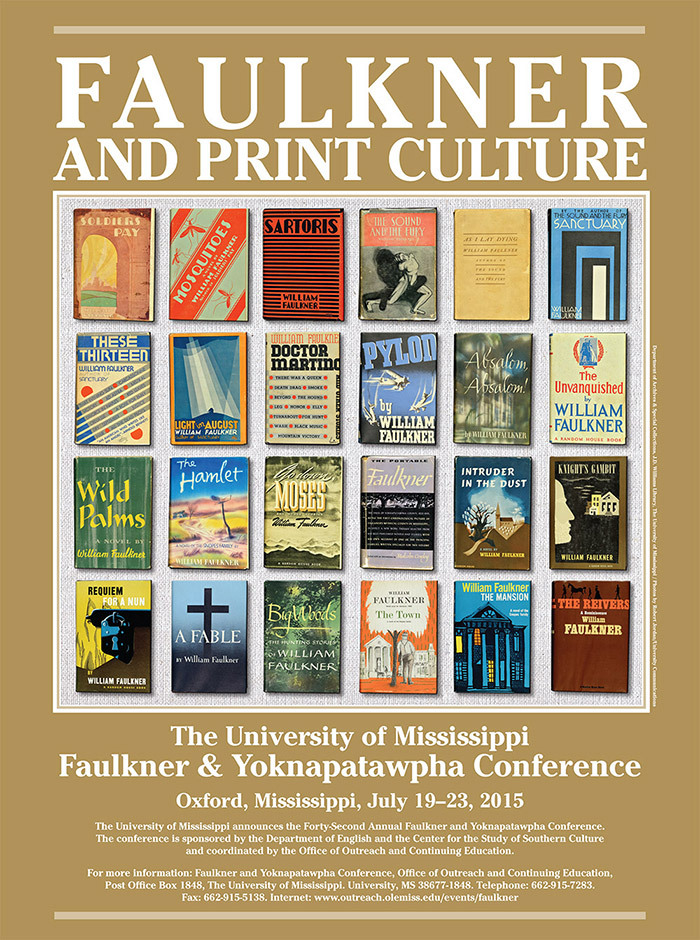
Panel. The Letter and the Image: Print Culture as Medial Interface
Location
Nutt Auditorium
Start Date
21-7-2015 9:30 AM
Description
- Writing Home, Writing Hollywood / Sarah Gleeson-White, University of Sydney
Faulkner’s Hollywood letters (1931-1960) reveal his coming into professionalism: they track his exuberance vis-à-vis his earliest motion-picture projects, the sheer desperation of the Warner Brothers years and, finally, the emergence of the canny negotiator, poised to take on the newer medium of television. They also reveal the way in which he came to conceive of his so-called great works – such as Absalom, Absalom! and The Sound and the Fury – as potential cash cows in the motion-pictures marketplace. More broadly, Faulkner’s Hollywood letters enable us to think further about the relation between private and public spheres, and manuscript and print cultures. - “Love,” “Manservant,” and the Aviation Background of Faulkner's First Hollywood Screenplay / Michael Zeitlin, University of British Columbia
Faulkner, arriving at Sam Marx’s office on the MGM lot on May 7, 1932, would not meet Howard Hawks for another two months. In this period, when he was truly on his own, he turned to “Love,” a story he had written in 1921, to abstract the rudiments of what he hoped would be a serviceable screenplay. It’s a bizarre scene, and an occasion to speculate into what I would like to think of as print culture’s unconscious. - Comic Strips -- Hybridity -- Pylon / Taylor Hagood, Florida Atlantic University
In Pylon, William Faulkner describes the Feinman Airport in New Valois by referencing the kinds of images found in comic strips. While scholars have noted the impact of film and Faulkner’s Hollywood experiences on Pylon, less discussed are the ways the unique qualities of spatial organization, color, and storytelling featured in comics exert a powerful influence. This paper will examine the novel’s indebtedness to comics from Buck Rogers to The Yellow Kid, paying particular attention to the ways Faulkner works out issues of race within the context of print culture. - Between the Literary and the Visual: Print Culture and Adaptation / Peter Lurie, University of Richmond
Relational Format
Conference proceeding
Recommended Citation
Gleeson-White, Sarah; Zeitlin, Michael; Hagood, Taylor; and Lurie, Peter, "Panel. The Letter and the Image: Print Culture as Medial Interface" (2015). Faulkner and Yoknapatawpha Conference. 14.
https://egrove.olemiss.edu/fy/2015/schedule/14
COinS
Jul 21st, 9:30 AM
Panel. The Letter and the Image: Print Culture as Medial Interface
Nutt Auditorium
- Writing Home, Writing Hollywood / Sarah Gleeson-White, University of Sydney
Faulkner’s Hollywood letters (1931-1960) reveal his coming into professionalism: they track his exuberance vis-à-vis his earliest motion-picture projects, the sheer desperation of the Warner Brothers years and, finally, the emergence of the canny negotiator, poised to take on the newer medium of television. They also reveal the way in which he came to conceive of his so-called great works – such as Absalom, Absalom! and The Sound and the Fury – as potential cash cows in the motion-pictures marketplace. More broadly, Faulkner’s Hollywood letters enable us to think further about the relation between private and public spheres, and manuscript and print cultures. - “Love,” “Manservant,” and the Aviation Background of Faulkner's First Hollywood Screenplay / Michael Zeitlin, University of British Columbia
Faulkner, arriving at Sam Marx’s office on the MGM lot on May 7, 1932, would not meet Howard Hawks for another two months. In this period, when he was truly on his own, he turned to “Love,” a story he had written in 1921, to abstract the rudiments of what he hoped would be a serviceable screenplay. It’s a bizarre scene, and an occasion to speculate into what I would like to think of as print culture’s unconscious. - Comic Strips -- Hybridity -- Pylon / Taylor Hagood, Florida Atlantic University
In Pylon, William Faulkner describes the Feinman Airport in New Valois by referencing the kinds of images found in comic strips. While scholars have noted the impact of film and Faulkner’s Hollywood experiences on Pylon, less discussed are the ways the unique qualities of spatial organization, color, and storytelling featured in comics exert a powerful influence. This paper will examine the novel’s indebtedness to comics from Buck Rogers to The Yellow Kid, paying particular attention to the ways Faulkner works out issues of race within the context of print culture. - Between the Literary and the Visual: Print Culture and Adaptation / Peter Lurie, University of Richmond

